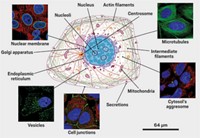Advertisement
Grab your lab coat. Let's get started
Welcome!
Welcome!
Create an account below to get 6 C&EN articles per month, receive newsletters and more - all free.
It seems this is your first time logging in online. Please enter the following information to continue.
As an ACS member you automatically get access to this site. All we need is few more details to create your reading experience.
Not you? Sign in with a different account.
Not you? Sign in with a different account.
ERROR 1
ERROR 1
ERROR 2
ERROR 2
ERROR 2
ERROR 2
ERROR 2
Password and Confirm password must match.
If you have an ACS member number, please enter it here so we can link this account to your membership. (optional)
ERROR 2
ACS values your privacy. By submitting your information, you are gaining access to C&EN and subscribing to our weekly newsletter. We use the information you provide to make your reading experience better, and we will never sell your data to third party members.
Analytical Chemistry
Researchers Map The Molecular Makeup Of The Human Skin Surface
Microbiome: Using a combo of mass spec and RNA sequencing, scientists plots the relationship among health, hygiene, and our bacterial residents
by Celia Henry Arnaud
April 1, 2015
| A version of this story appeared in
Volume 93, Issue 14

The skin’s surface has long been terra incognita. Although scientists have charted some of its molecular makeup, they haven’t had a detailed map.
But now, researchers have reported a three-dimensional plot of the microbes and molecules found on the surface of human skin (Proc. Natl. Acad. Sci. USA 2015, DOI: 10.1073/pnas.1424409112). The map blazes a trail for understanding the interplay among health, hygiene, and the human microbiome.
This project “gives a much more detailed view of how microbes and metabolites change over the surface of the body than our previous work in this area,” says Rob Knight, a professor of biomedical sciences at the University of California, San Diego, who has been involved in previous microbiome projects and was responsible for the microbial sequencing performed in the new study.
To map the composition of the skin, the researchers swabbed 400 1-inch-square spots on each of two volunteers, a man and a woman, who hadn’t showered or applied lotions, creams, or shampoos for three days. The spots were on only one half of the body. From each swab, the researchers identified microbes using ribosomal RNA sequencing and metabolites produced by a person’s body and by the bacteria using mass spectrometry.
“At the onset of the study, we made the incorrect assumption that much of the chemistry would be driven by the skin microbes,” says Pieter C. Dorrestein, a professor of pharmacology, chemistry, and biochemistry at UC San Diego who led the study. “We were surprised that the majority of the chemistry we saw was actually not driven by the microbial communities present on the skin.”
Instead, the biggest source of identifiable molecules on the skin was personal care products. “We were not expecting how long the traces of our daily routines are visible on the skin,” Dorrestein says.
To see how the microbes and the metabolites are distributed, team member Theodore Alexandrov, a group leader at the European Molecular Biology Laboratory in Heidelberg, Germany, mapped the metabolites and microbes for each of the collection spots onto 3-D models of the human body. By using that spatial information, he was able to relate tens of thousands of molecular signals to hundreds of microbial types, which led to the identification of molecular players involved in human-microbial interactions.
“By putting the microbial and metabolic information into the same spatial reference frame, we can start to make conjectures about which microbes perform specific chemical transformations, then test these hypotheses in the laboratory,” Knight says. “This includes information both about how microbes break down compounds made by human cells and about how they metabolize sunscreen, moisturizer, and other products we apply to our bodies.”
“Combining the two rich data sets of bacterial and chemical composition contributes a rich understanding to how microbes modify and select their environments,” says Julie Segre, a scientist at the National Institutes of Health who studies the human microbiome. “This study of healthy individuals sets the stage to explore many physiologic changes associated with aging or disease. The visual displays in this paper are simply the coolest science.”



Join the conversation
Contact the reporter
Submit a Letter to the Editor for publication
Engage with us on Twitter